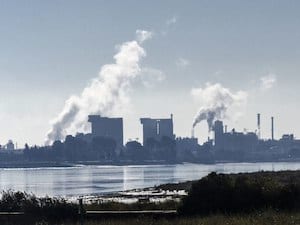
THURSDAY, March, 15, 2018 (HealthDay News) — Air pollution takes a greater toll on the hearts of black Americans than whites, in part because they often live in poorer areas with more pollution, a new study suggests.
“The greater risk of death from heart disease among blacks, compared with whites, is partially explained by higher exposure to air pollution,” said lead researcher Dr. Sebhat Erqou, a fellow in cardiovascular disease at the University of Pittsburgh.
The western Pennsylvania study looked at the relationship between heart disease and a component of air pollution known as fine particulate matter. Fine particulate matter (called PM2.5, which is about 40 times smaller than the width of a human hair) stems from factories, vehicles, power plants, fires and secondhand smoke.
Researchers found that blacks living in areas where this type of pollution is high have a 45 percent higher risk of heart disease and death from any cause than whites, even after taking into account other common risk factors.
But about one-quarter of that elevated risk was attributed to their greater exposure to dirty air, which correlated with poverty, Erqou said.
Blacks and other minorities more often live close to sources of environmental pollution, such as highways, the researchers said in background notes.
As income and education increased, the impact of air pollution decreased, Erqou said.
Chronic exposure to air pollution has been associated with numerous ill effects, included elevated blood sugar, poorly functioning blood vessels, heart disease and death, he noted.
This study reflects, again, racial disparities that exist in medical outcomes, said Dr. Rachel Bond, associate director for women’s heart health at Lenox Hill Hospital in New York City.
“Air pollution clearly has a detrimental effect on the black community disproportionate to the white community with respect to cardiac disease outcomes,” said Bond, who was not part of the study.
Another New York specialist who was not involved with the research pointed to the broad role economic differences can play.
“Exposure to air pollution may be more of a factor of socioeconomic status than race itself, and there may be confounders such as smoking history, home environment and occupation, which can affect health,” said Dr. Walter Chua. He’s a senior pulmonary attending physician at Long Island Jewish Forest Hills.
For the study, Erqou and colleagues reviewed data on PM2.5 and black carbon, which is an ultrafine component of PM2.5, from a Pittsburgh-area air monitoring campaign.
The researchers combined that with information from an ongoing heart study involving more than 1,700 residents (average age 59) of western Pennsylvania.
Each year, participants complete questionnaires that ask about heart-related hospitalizations, heart attacks, acute coronary syndrome, stroke, angioplasty or death from heart disease.
Erqou’s team found that greater PM2.5 exposure was associated with increased blood sugar, worse blood vessel function, and higher odds for problems such as heart attack and stroke, and death from all causes.
The investigators also found that compared with whites, blacks had significantly higher average exposures to PM2.5 and black carbon.
A weakness of the study is that it’s limited to one city, so the findings might be different in other locales, Erqou said. Also, the study only found an association rather than a cause-and-effect link.
Chua said it would be interesting to look at other major cities, including New York and San Francisco, to see if these disparities still exist, given that those cities are more diverse, he said.
Meanwhile, “the push to maintain good air quality should still continue,” Chua said.
The report was published March 15 in the journal Arteriosclerosis, Thrombosis and Vascular Biology.
More information
For more on air pollution and heart disease, visit the American Heart Association.
